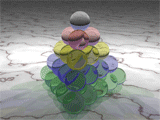Tetrahedral number

A tetrahedral number, or triangular pyramidal number, is a figurate number that represents a pyramid with a triangular base and three sides, called a tetrahedron. The nth tetrahedral number is the sum of the first n triangular numbers.
The first ten tetrahedral numbers are:
Formula
The formula for the n-th tetrahedral number is represented by the 3rd rising factorial of n divided by the factorial of 3:
The tetrahedral numbers can also be represented as binomial coefficients:
Tetrahedral numbers can therefore be found in the fourth position either from left or right in Pascal's triangle.
Geometric interpretation
Tetrahedral numbers can be modelled by stacking spheres. For example, the fifth tetrahedral number (T5 = 35) can be modelled with 35 billiard balls and the standard triangular billiards ball frame that holds 15 balls in place. Then 10 more balls are stacked on top of those, then another 6, then another three and one ball at the top completes the tetrahedron.
When order-n tetrahedra built from Tn spheres are used as a unit, it can be shown that a space tiling with such units can achieve a densest sphere packing as long as n ≤ 4.[1]
Properties
- Tn + Tn-1 = 12 + 22 + 32 ... + n2
- A. J. Meyl proved in 1878 that only three tetrahedral numbers are also perfect squares, namely:
- T1 = 1² = 1
- T2 = 2² = 4
- T48 = 140² = 19600.
- Sir Frederick Pollock conjectured that every number is the sum of at most 5 tetrahedral numbers: see Pollock tetrahedral numbers conjecture.
- The only tetrahedral number that is also a square pyramidal number is 1 (Beukers, 1988), and the only tetrahedral number that is also a perfect cube is 1.
- The infinite sum of tetrahedral numbers' reciprocals is 3/2, which can be derived using telescoping series:
- The parity of tetrahedral numbers follows the repeating pattern odd-even-even-even.
- An observation of tetrahedral numbers:
- T5 = T4 + T3 + T2 + T1
- Numbers that are both triangular and tetrahedral must satisfy the binomial coefficient equation:
- The only numbers that are both Tetrahedral and Triangular numbers are (sequence A027568 in the OEIS):
- Te1 = Tr1 = 1
- Te3 = Tr4 = 10
- Te8 = Tr15 = 120
- Te20 = Tr55 = 1540
- Te34 = Tr119 = 7140
Popular Culture
Te12 = 364, which is the total number of gifts "my true love sent to me" during the course of all 12 verses of the carol, "The Twelve Days of Christmas".[2] The cumulative total number of gifts after each verse is also Ten for verse n.
See also
References
External links
- Geometric Proof of the Tetrahedral Number Formula by Jim Delany, The Wolfram Demonstrations Project.
- On the relation between double summations and tetrahedral numbers by Marco Ripà